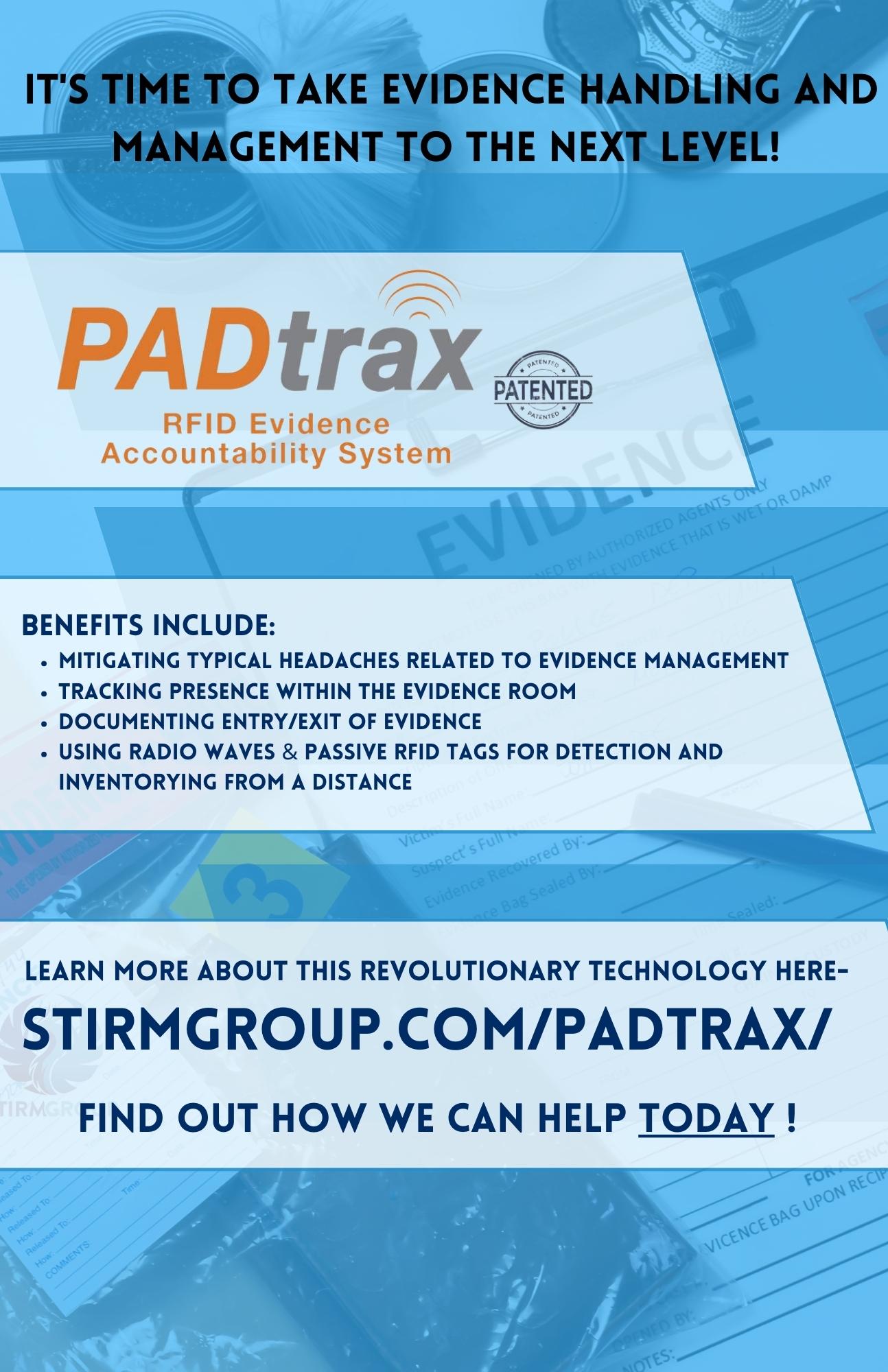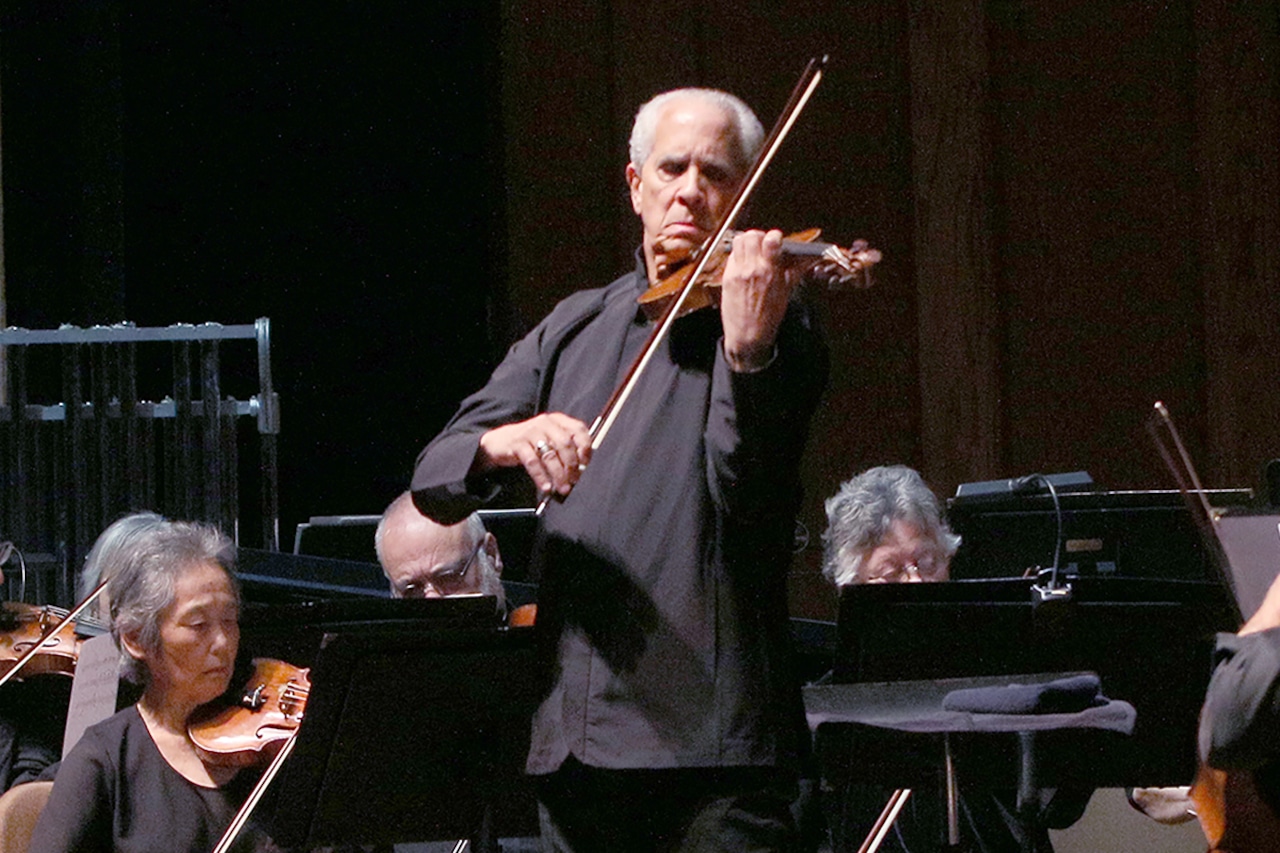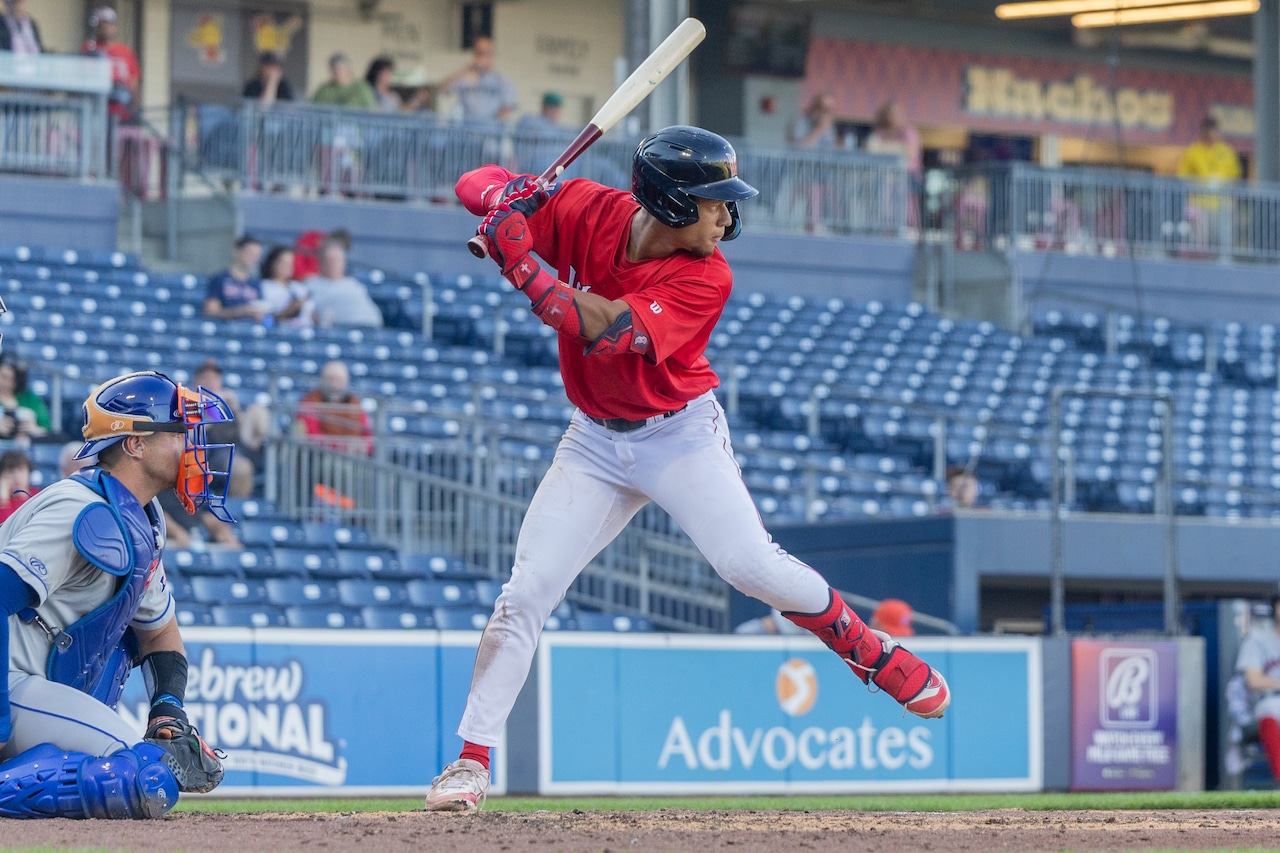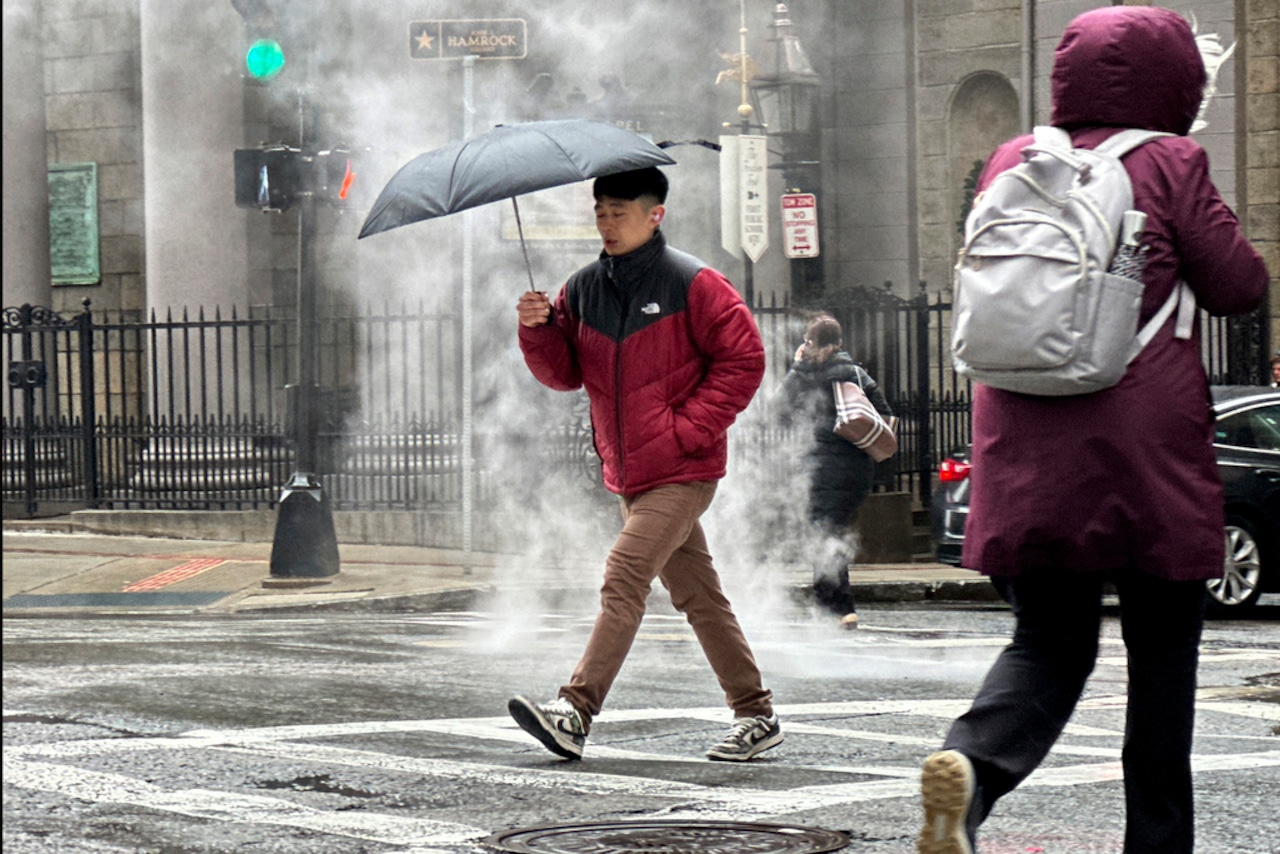Dave Dombrowski selected two pitchers in the first round in his four MLB Drafts when he served as Red Sox president of baseball operations from 2016-19. He batted .500.
Dombrowski, who now serves as Phillies president of baseball operations, drafted lefty Jay Groome 12th overall in 2016 out of Barnegat High and it didn’t work out. Groome has a 5.54 ERA in 103 outings (101 starts) in the minors. The 25-year-old, now a member of the Padres system, has not pitched in the majors and is serving a one-year suspension for betting on baseball.
He drafted righty Tanner Houck 24th overall in 2017 out of Mizzou and it worked out. Houck made the 2024 AL All-Star team and has the seventh-best odds to win the AL Cy Young, per DraftKings.
“The problem you run into — it’s the old adage — it’s the greatest risk but if you don’t have pitching, you’re not going to win,” Dombrowski said at the GM Meetings last November talking generally about drafting pitchers in the first and early rounds. “So you have to weigh the factors and make a decision in that regard. Because if you always take the safer route of the positional player, you’re gonna have a lot of positional players but you’re not going to have any pitching.”
The Red Sox haven’t drafted a pitcher in the first round since Houck in 2017. They drafted just one pitcher in the top three rounds — 2022 third-rounder Dalton Rogers out of Southern Mississippi — under former chief baseball officer Chaim Bloom from 2020-23.
New chief baseball officer Craig Breslow will be in charge of his first Red Sox draft Sunday-Tuesday. The former big league pitcher is known for being a pitching guru, so will he change the trend? Will he draft a pitcher in the first round? Will he draft more pitchers in the higher rounds?
As of July 10, 30 MLB pitchers had a Fangraphs WAR of 1.9 or higher. Thirteen (43.3%) were former first round draft picks. Twenty-seven of the 30 were former draft picks and three were former international signees. Of the 27 former draft picks, 19 (70.4%) were drafted in the top five rounds.
“My general sentiment on the draft is that it’s a fairly simple straightforward process in that you collect as much unique and predictive information as you possibly can about players and then you generally take the best player that’s available independent of position,” Breslow said. “Because it’s a way to add talent to the organization in a pretty straightforward way.”
Breslow said the teams generally successful at developing pitching are the ones that take more “shots on goal.” In other words, successful teams bring in a high volume of pitchers whether it be through the draft, trade, free agency, international free agency and minor league free agency.
“Do we need to be disciplined in terms of how much talent we’ll be leaving on the board in chasing pitching vs. position players?” Breslow said. “Absolutely. And that’s the concern. … We should be able to kind of turn position player talent into pitching talent.”
Turning position player talent into pitching of course can happen via the trade market.
“Generally, I think the teams that do well with development, they don’t overthink the draft,” Breslow said. “They take the player that’s the best available in front of you and develop the heck out of him.”
SUCCESS RATE DRAFTING PITCHERS IN FIRST ROUND
In the 15 drafts from 2000-14, 368 first round draft picks were used on pitchers (257 right-handers, 111 left-handers). Sixty-nine of those first round draft picks (18.8%) have recorded a career WAR of 10 or higher. Twenty-five drafted pitchers (6.8%) have recorded a WAR of 20 or higher.
Seventy-three percent of first-round draft picks used on pitchers in these 15 drafts resulted in major league pitchers. So 27% failed to make it.
The Red Sox have two drafted and developed pitchers — Houck (2017 first round) and Kutter Crawford (2017 16th round) — in this year’s rotation. Both righties are among the group of 30 pitchers with a Fangraphs WAR of 1.9 or higher.
Boston also developed starter Brayan Bello after signing him out of the Dominican Republic in 2017. But the Red Sox, for the most part, have had difficulty drafting and developing pitchers the past 15 years. Every member of the 2018 World Series starting rotation — Chris Sale, David Price, Rick Porcello, Nathan Eovaldi and Eduardo Rodriguez — was acquired via trade or free agency.
“It’s really hard to acquire starting pitching whether it’s through the free agent market, developing your own, drafting your own, international,” Royals GM J.J. Picollo said. “So if you’re able to get a guy in the first round that’s in your rotation, generally most scouting directors would tell you that’s a successful draft.”
Ideally, Picollo added, the pitcher turns into an ace. But he noted that there might be only 10 true aces over 15 drafts.
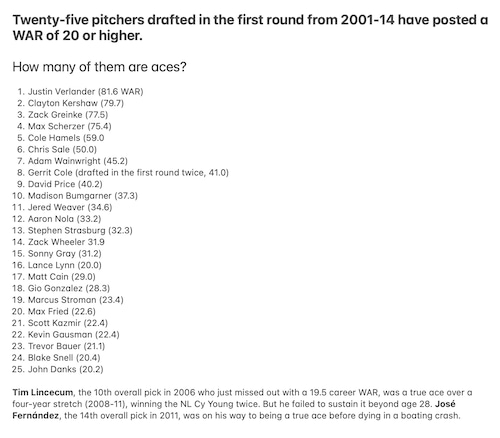
Here’s a list of the 25 pitchers drafted from 2001-14 who have posted a WAR of 20 or higher.Christopher Smith
Dombrowski thinks there’s “for sure” greater risk in taking a pitcher in the first round “just because pitchers get hurt more than position players.” He also considers drafting high school pitchers riskier than taking college pitchers, calling it “the greatest risk in the draft.”
Dombrowski added, “When you’re talking about drafting a guy in the first round, there’s a difference in the first round between top five vs. 25th. There’s a lot of difference between the two.”
Reds president of baseball operations Nick Krall doesn’t necessarily see greater risk with pitchers.
“We took Hunter Greene as a hard-throwing right-hander second overall (2017) and he’s worked out,” Krall said. “And we’ve taken guys who are position players who haven’t worked out. There’s risk in everything. I think it’s just trying to figure out what that risk is.”
DECLINE IN RED SOX DRAFTING TOP ROUND PITCHERS
The Red Sox have continued to draft fewer pitchers in the top five rounds with each new GM they have hired in the 21st century.
Theo Epstein drafted an average of 3.33 pitchers in the first five rounds of his nine drafts as Red Sox GM from 2003-11. He selected 12 pitchers in the first round (including supplementary picks): Craig Hansen (2005), Clay Buchholz (2005), Michael Bowden (2005), Daniel Bard (2006), Kris Johnson (2006), Caleb Clay (2006), Nick Hagadone (2007), Casey Kelly (2008), Bryan Price (2008), Anthony Ranaudo (2010), Matt Barnes (2011) and Henry Owens (2011).
Ben Cherington drafted an average of 3.25 pitchers in the first five rounds of his four drafts as GM from 2012-15. He selected four pitchers in the first round: Brian Johnson (2012), Pat Light (2012), Trey Ball (2013) and Michael Kopech (2014).
Dombrowski drafted an average of 2.5 pitchers in the first five rounds of his four drafts as president of baseball operations from 2016-19. As noted, he selected two pitchers in the first round: Groome (2016) and Houck (2017).
Bloom drafted an average of 1.75 pitchers in the first five rounds of his four drafts as Red Sox chief baseball officer from 2020-23 and never selected a pitcher in the first round.
Of the 18 first round picks above, Buchholz (16.8), Bard (8.4), Houck (8.3), Kopech (4.6) and Barnes (4.1) have been the most successful. Three pitchers (Clay, Ball and Groome) didn’t or haven’t made it to the big leagues. Seven finished with a career WAR of 0.1 or lower, including five in the negatives.
“The draft is a bit of a crapshoot,” Breslow said. “It’s becoming less of a crapshoot as we’re collecting more and more information about players. The huge asymmetry in information collection between college players and high school players is significant. Generally, the sentiment is that college position players are kind of the most predictable demographic.”
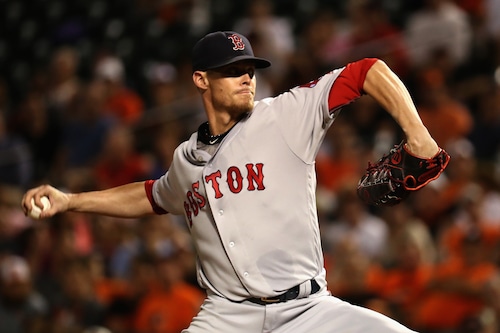
Clay Buchholz has the highest WAR among pitchers the Red Sox have drafted in the first round since 2003. (Photo by Rob Carr/Getty Images)Getty Images
As Breslow mentioned, the Red Sox are looking to take the best player on the board independent of position.
“If you were to say, ‘Hey, all else being equal — we think we’ve got kind of the same talent level between a pitcher and a position player — does it make sense to get the pitcher like given our situation?’ I think there’s a compelling argument to say, ‘Yes,’” Breslow said.
But Breslow said they need to stay disciplined in deciding the talent level between the pitcher and position player. That position talent can be flipped eventually for pitching. But he also said he’s learned over the past six to eight months that every team values cost control pitching, especially starting pitchers who can generate swings and misses. He called the trade price for that “exorbitantly expensive.”
“And so if you have a chance to add that to your organization via the draft, it’s something you need to be open to,” Breslow added.
INJURIES ADD TO THE RISK
Forty-seven professional pitchers, including 23 minor leaguers, have undergone Tommy John surgery since Jan. 1, according to MLB researcher Jon Roegele who has tracked more than 2,468 cases in pro ball starting with Tommy John himself in 1974. His list includes 787 TJ surgeries since the start of 2018.
At least 18 pitchers drafted in 2022 — including six first-rounders and four second-rounders — have since undergone Tommy John surgery.
But teams aren’t shying away from pitchers who underwent a recent Tommy John surgery. At least nine pitchers from the 2023 draft underwent Tommy John surgery in the year prior to being selected. That said, only two of the picks were from higher than the fourth round. Four were fourth-rounders and zero were fifth-rounders.
“If you eliminated any pitcher who has had Tommy John surgery, you would be fishing in a very, very small pond,” Breslow said. “And so I think the way the industry treats Tommy John surgery is different now. We realize there are plenty of pitchers who have had the surgery and have overcome it and gone on to have incredibly successful careers. But it’s not without risk. We know there’s significant risk with your second surgery relative to your first and third relative to second. I think we just need to synthesize all that information.”
Athletics GM David Forst said he feels “the best predictor of future health is past health.”
“And you try to find guys who have a track record,” Forst said.
Rays president of baseball operations Erik Neander added, “Even from one year to the next right now at the major league level, it’s as difficult as it’s ever been to determine who’s going to be most effective and more so, who’s going to be healthy.”
WHAT DO TEAMS LOOK FOR IN FIRST-ROUNDER?
Teams typically want their top draft picks to have shown strong command as an amateur. Picollo said a pitcher averaging 4.5-to-5 strikeouts per nine innings might not be someone a team wants to “invest a lot of money in” at the top of the draft but he might be someone to pick as a “wild card” later in the draft. Forst, meanwhile, noted it’s easier to increase velocity than fix command issues because of programs created by Driveline Baseball and Tread Athletics that use weighted balls and other tools to do it.
“Improving command is a little less science and a little more art, I guess,” Forst said. “Obviously you work on guys having repeatable deliveries and their mechanics. But it’s a little harder to measure.”
Rangers GM Chris Young said a pitcher’s character is near the top of the list for him.
“Are you willing to bet on the person?” Young said. “They have to be unbelievably talented to be considered in the first round. But what are the other attributes that are going to make that player successful over time, especially when things get tough?”
Picollo also mentioned makeup, how the pitcher competes and how he deals with adversity. He said he wants to know if the draft pick can “get back up, stand on his feet and go compete again in five days” after getting “punched in the face.”
“You think you can figure it out watching them in college but usually in college and high school they are so dominant that it’s hard to really tell if they have that in them,” Picollo said. “So it’s the intangibles that separate those No. 1 picks.”
Twins president of baseball operations Derek Falvey pointed to athleticism.
“Whether it’s a high school kid or college kid, he’s not going to look like what he’s going to look like five years from now when he’s pitching in a major league game,” Falvey said. “There’s a lot of development left. So you want to look at the ingredients. How does the body move? How does the arm work? Does he have feel? Does he make adjustments well? When he’s losing his fastball arm side a bunch because he’s a young kid ripping it at 96 (mph), can he get himself back in the zone? Can he make those adjustments athletically?”
Falvey added that consistency of release point and pitch grips are types of things that can be taught but “you can’t teach the athleticism.”
Marlins president of baseball operations Peter Bendix said it’s important to evaluate the player at present but also project what he might be in five years, especially his physical maturity.
“How big and strong is he going to be?” Bendix said. “How tall is he going to get? Can he take on more muscle? Is he going to get fat? Is he going to stay in shape? All these different things because so much of it is physical based.”
With increased size can come added velocity. Falvey no longer feels one is more difficult than the other between increasing velocity and improving command.
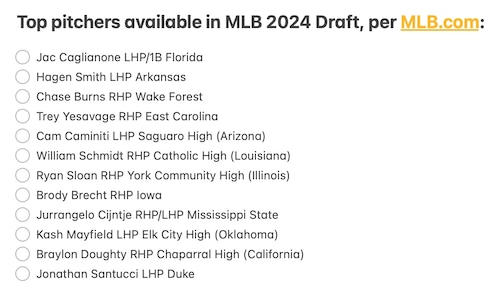
This list of the top amateur pitchers available in the 2024 MLB Draft. It includes a switch-pitcher and a two-way player.Christopher Smith
As multiple GMs mentioned, advanced technology in recent years has helped to get a better understanding of biomechanics and what can be done to help refine a pitcher’s command.
On fixing command, Falvey added, “Often times, there’s maybe a gap in consistency in release, consistency in the way they’re attacking. Or maybe there’s a grip issue. Maybe there’s some other mechanical traits that are a little off. But sometimes it’s really simplifying the mix. Sometimes a guy has too many pitches.”
Neander mentioned delivery, free-moving actions, potential for strike-throwing and “room for a lot more power down the road” as part of Tampa’s evaluation of amateur pitchers.
DRAFTING TOP ROUNDERS
The Reds drafted Rhett Lowder seventh overall in 2023 out of Wake Forest.
“With him we looked at what’s his ceiling?” Krall said. “What’s his compete? What’s his makeup? What’s his aptitude to develop? Those are the questions that we ask. Obviously what’s his stuff? What’s his command? But there’s also a lot of intangibles. If we took anybody in the first round, it’s trying to figure out what the intangibles of that player are and how they can develop because they’re going to go to the minor leagues for a period of time.”
The Guardians’ 2023 starting rotation had three top rookies — 2021 first rounder Gavin Williams, 2021 fifth rounder Tanner Bibee and 2020 second-rounder Logan Allen — they drafted and developed. Cleveland GM Mike Chernoff called them “three completely different pitchers.”
“I think we’re open to a lot of different profiles,” Chernoff said. “Gavin Williams was throwing 100 mph. Big, strong guy throwing 100 mph in college. Tanner Bibee was an unheralded prospect. He pitched in college and then made huge velocity gains and delivery improvements through the minor leagues. And then Logan Allen is more of a soft tossing guy who had a totally different profile and gained velocity over time in our system but is a much different profile pitcher.”
Chernoff said it’s important to look at a pitcher’s strengths and help him grow those strengths while potentially developing some of the areas of weakness. He said it needs to be “a really collaborative effort between scouting and development” departments.
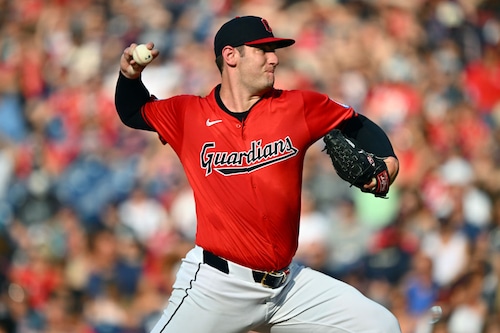
The Guardians have been successful in draft and developing pitching. That includes selecting Gavin Williams in the first round in 2021. (Photo by Jason Miller/Getty Images)Getty Images
Nationals president of baseball operations/GM Mike Rizzo has been unafraid to take pitchers in the first round. He has drafted 10 pitchers in the first round over 15 drafts since 2009, including Stephen Strasburg, Lucas Giolito, Drew Storen and Dane Dunning.
“I think if you look at my record, I’ve picked a lot of pitchers over position players,” Rizzo said. “I like to pick the best player. And it doesn’t matter if it’s a pitcher or a player. Certain years it falls that it’s a position player. Certain years it falls as a pitcher.”
IT’S ALL DIFFICULT
The draft is a crapshoot simply because talent evaluation at the amateur level is extremely difficult, especially projecting what the player will be in five years.
“To project into the future is the most important part and the hardest part,” Bendix said.
Look beyond pitchers. Four teams — the Pirates, Cardinals, Rangers and Rays — passed on Aaron Judge twice in the 2013 Draft. It was difficult to project whether he would make enough contact to be a successful major leaguer.
The Yankees even used a higher ‘13 first-round pick on Eric Jagielo who never made the majors. MassLive wrote a story in Feb. 2017 about how Mookie Betts and Mike Trout went overlooked. In that piece, MassLive reported 277-of-850 — or 33% — of the first-round draft selections (pitchers and position players) from 1990-2009 never recorded a single major league statistic.
“Hitter/pitcher, it’s difficult with everyone,” Young said.
Bendix added, “I think there’s a lot of things that are very difficult and that’s what makes this fun.”
After drafting the pitcher, another equal challenge presents itself.
“It’s as hard to develop as it is to draft,” Forst said. “We spend so much time talking about pitchers’ health and injuries. That’s a huge part of the equation. When you look at the odds of high school pitchers staying healthy all the way to the big leagues or frankly right now any pitcher staying healthy, you have to factor in that risk any time you’re taking a chance on a guy at the top.”
Neander said it’s important to start with helping the pitcher “appreciate the things he does well.”
“You make sure they believe in why they are there and what they can do and you lean into that,” he said.
* Interviews (and information gathered for this story) were conducted over the past eight months, beginning at the 2023 GM Meetings in Scottsdale, Ariz.


